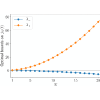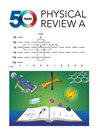Quantum backflow current in a ring: Optimal bounds and fractality
IF 2.9
2区 物理与天体物理
Q2 Physics and Astronomy
引用次数: 0
Abstract
The probability density of a quantum particle moving freely within a circular ring can exhibit local flow patterns inconsistent with its angular momentum, a phenomenon known as quantum backflow. In this study, we examine a quantum particle confined to a ring and prepared in a state composed of a fixed (yet arbitrary) number of lowest-energy eigenstates with nonnegative angular momentum. We investigate the time-dependent behavior of the probability current at a specified point along the ring's circumference. We establish precise lower and upper bounds for this probability current, thereby delineating the exact scope of the quantum backflow effect. We also present an analytical expression for a quantum state that yields a record-high backflow probability transfer, reaching over of the theoretical bound. Furthermore, our investigation yields compelling numerical and analytical evidence supporting the conjecture that the current-versus-time function associated with states maximizing backflow probability transfer forms a fractal curve with a dimension of . The observed fractality may provide a characteristic, experimentally relevant signature of quantum backflow near the probability-transfer bound.

环中的量子逆流:最佳边界和分形
在圆环内自由移动的量子粒子的概率密度会表现出与其角动量不一致的局部流动模式,这种现象被称为量子逆流。在本研究中,我们研究了一个被限制在圆环内的量子粒子,它处于一种由固定数量(但任意)的具有非负角动量的最低能量特征态组成的状态。我们研究了沿环圆周指定点的概率电流随时间变化的行为。我们为这一概率电流确定了精确的下限和上限,从而划定了量子逆流效应的确切范围。我们还提出了一种量子态的分析表达式,它能产生创纪录的高逆流概率转移,达到理论界限的 95% 以上。此外,我们的研究还获得了令人信服的数值和分析证据,支持以下猜想:与逆流概率转移最大化状态相关的电流-时间函数形成了一条维度为 7/4 的分形曲线。观察到的分形可能是量子逆流在概率转移边界附近的一个特征性实验相关标志。
本文章由计算机程序翻译,如有差异,请以英文原文为准。
求助全文
约1分钟内获得全文
求助全文
来源期刊

Physical Review A
物理-光学
CiteScore
5.40
自引率
24.10%
发文量
0
审稿时长
2.2 months
期刊介绍:
Physical Review A (PRA) publishes important developments in the rapidly evolving areas of atomic, molecular, and optical (AMO) physics, quantum information, and related fundamental concepts.
PRA covers atomic, molecular, and optical physics, foundations of quantum mechanics, and quantum information, including:
-Fundamental concepts
-Quantum information
-Atomic and molecular structure and dynamics; high-precision measurement
-Atomic and molecular collisions and interactions
-Atomic and molecular processes in external fields, including interactions with strong fields and short pulses
-Matter waves and collective properties of cold atoms and molecules
-Quantum optics, physics of lasers, nonlinear optics, and classical optics
 求助内容:
求助内容: 应助结果提醒方式:
应助结果提醒方式:


